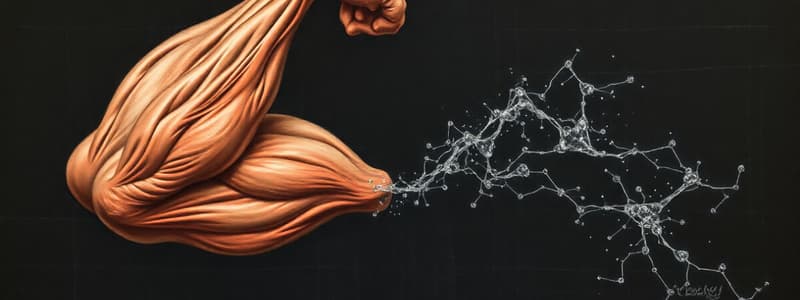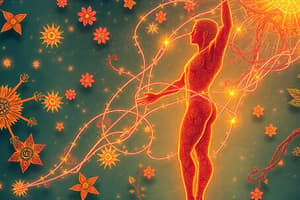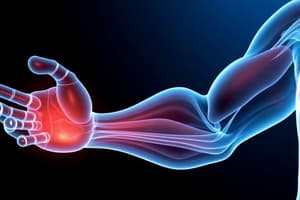Podcast
Questions and Answers
What happens to the energy sources for muscle contraction as exercise duration increases?
What happens to the energy sources for muscle contraction as exercise duration increases?
- Stored muscle energy decreases, while blood energy sources increase (correct)
- Glycogen is exclusively utilized and fatty acid use is eliminated
- ATP from cellular respiration becomes less efficient
- Use of triglycerides increases, while glycogen decreases
When ATP is depleted, which pathway is NOT one of the three ways muscle cells can regenerate ATP?
When ATP is depleted, which pathway is NOT one of the three ways muscle cells can regenerate ATP?
- Cellular respiration
- Creatine phosphate pathway
- Fermentation
- Anaerobic glycolysis (correct)
Which pathway produces ATP for muscle contraction the fastest?
Which pathway produces ATP for muscle contraction the fastest?
- Glycogenolysis
- Fermentation
- Creatine Phosphate Pathway (correct)
- Cellular Respiration
What is the primary limitation of the creatine phosphate pathway?
What is the primary limitation of the creatine phosphate pathway?
What byproduct is primarily produced during the anaerobic process of fermentation in muscle cells?
What byproduct is primarily produced during the anaerobic process of fermentation in muscle cells?
What role does myoglobin play in muscle cells?
What role does myoglobin play in muscle cells?
Which energy source is primarily utilized during prolonged aerobic exercise?
Which energy source is primarily utilized during prolonged aerobic exercise?
What physiological response occurs following strenuous exercise to manage lactate levels?
What physiological response occurs following strenuous exercise to manage lactate levels?
Which pathway is the most efficient for ATP production, albeit the slowest?
Which pathway is the most efficient for ATP production, albeit the slowest?
When does creatine phosphate primarily form in muscle cells?
When does creatine phosphate primarily form in muscle cells?
Which type of respiration occurs in mitochondria and involves multiple metabolic pathways?
Which type of respiration occurs in mitochondria and involves multiple metabolic pathways?
What is primarily released as a byproduct during cellular respiration?
What is primarily released as a byproduct during cellular respiration?
Flashcards are hidden until you start studying
Study Notes
Muscle Contraction
- The cycle of myosin attaching to actin and pulling it towards the center of the sarcomere is known as the ratchet mechanism, which shortens the sarcomere and thus the muscle.
- Myofibrils are the contractile units of a muscle fiber.
- Both ATP and calcium ions are essential for muscle contraction.
- ATP is required for the myosin heads to detach from actin and reattach further along the filament.
- Calcium ions bind to troponin, which moves tropomyosin away from myosin-binding sites on actin, allowing contraction to occur.
Energy Sources for Muscle Contraction
- Muscles obtain energy from four sources: glycogen and triglycerides stored within the muscle, and glucose and fatty acids from the blood.
- The source of energy used depends on the intensity and duration of exercise.
- As exercise time increases, the use of muscle energy stores decreases, while the use of energy sources from the blood increases.
ATP Production in Muscle Cells
- Muscle cells have limited ATP stores and produce more ATP through three pathways: the creatine phosphate pathway, fermentation, and cellular respiration.
- The creatine phosphate pathway is the simplest and fastest way to produce ATP, using creatine phosphate stored in the muscle during rest. This pathway provides energy for the first few seconds of muscle contraction.
- Fermentation is an anaerobic process that produces ATP by breaking down glucose to lactate. It is fast-acting but leads to lactate buildup, causing short-term muscle aches and fatigue.
- Cellular respiration is the slowest but most efficient pathway for ATP production. It occurs in the mitochondria and uses oxygen, glucose, and fatty acids as energy sources.
Muscle Fiber Contraction
- Motor neurons stimulate muscle fibers to contract.
- A motor neuron's axon branches out to stimulate multiple muscle fibers.
- The neuromuscular junction is the point of contact between an axon terminal and the sarcolemma (muscle cell membrane).
- Acetylcholine (ACh) is a neurotransmitter released from synaptic vesicles at the axon terminal.
- ACh binds to receptors on the sarcolemma, triggering electrical signals that spread down the T tubules and cause calcium to be released from the sarcoplasmic reticulum.
- Calcium ions bind to troponin, which moves tropomyosin away from myosin-binding sites on actin, allowing myosin to bind and initiate the power stroke.
- ATP is required for myosin to detach from actin and reattach further along the filament, continuing the contraction cycle.
- The binding of ATP to myosin heads breaks the cross-bridges between myosin and actin.
Studying That Suits You
Use AI to generate personalized quizzes and flashcards to suit your learning preferences.





